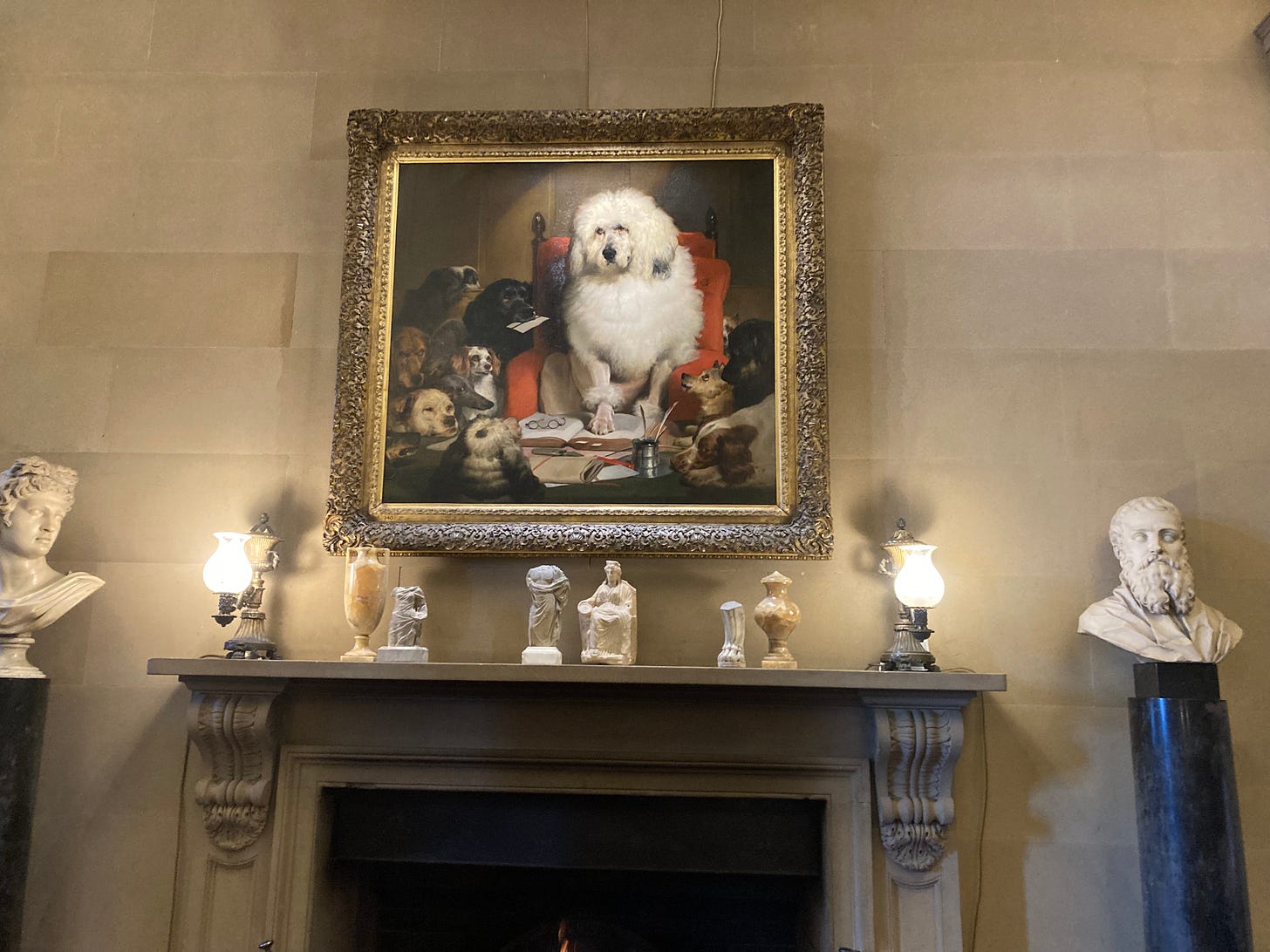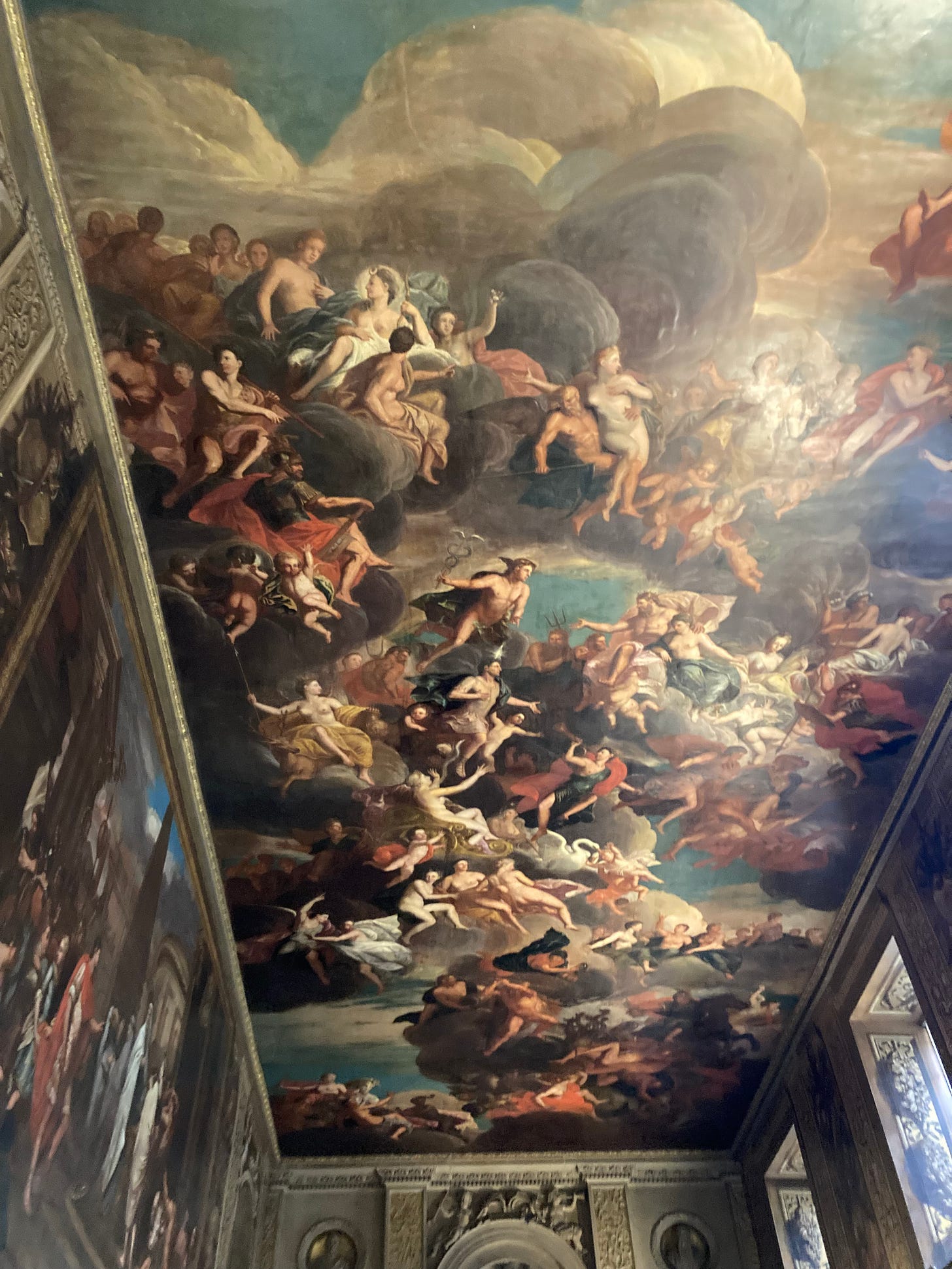For this post, we are going back to the beginning with Chatsworth, before I even began to be irritated with the unlabelled ceramics and classical fragments, so let’s cross the threshold once again. This time we will note that visitors don’t enter through the front door - I’m not even sure I know where that is - but into a kind of servant undercroft, a forest of dark columns on the lower ground floor, with few furnishings and some questionable art.
I quite like the simplicity of this space and could write a whole piece on how servants quarters, functional and clean, look better than the cluttered extravagance of above stairs, but that’s not what I came back in for. We are here to ascend into excess.
The first room that you tour in Chatsworth - as opposed to simply arriving in - is the Painted Hall. Which does what it says on the tin; the ceiling and the walls are covered in swirling murals of gods and people and allegory. I’ll come to what they mean another time, and pay more attention to the fact that the clothes of many of the women have also fallen off, but for now let’s just sit with the feeling of overwhelm. The murals could achieve this all on their own, even without the addition of a gilded gallery and stair, vast pillars of carved stonework and a general feeling that at no point has anyone thought it was a good idea to say, no, that’s enough.
What’s really interesting is that I have only ever read one sensible piece of commentary about this room. Mostly the visitor is just meant to admire the Painted Hall as the jewel of Chatsworth, a masterpiece of the Baroque and so on (one day I am going to set AI to writing guidebooks and room descriptions because it might be more revealing and less obsequious than what gets written by humans). A deeper dive into art and design history, merely produces a different version of the same thing, with more words (“this sumptuous, dizzying, dramatic interior”) and then an elucidation of the meaning of the murals.
What no one is talking about is what this interior and its murals are here to do. And that’s intimidate us into submission. This room wants me to feel small, and in truth is doing a pretty good job of this. But the only place I have ever seen this mentioned* is in a piece about a child-friendly guide to the house, in which a small boy was asked what he thought of the hall, and he said that it was to show how important and powerful the owner was.
He is, of course, entirely right. The murals do want tell subtle tales of limited kingship and democracy, the stairs may just be here to take you up to the first floor, but the point of this room - and indeed the whole rest of the house - is to remind the visitor that the Duke of Devonshire is rich and powerful beyond our wildest imaginings while everyone else, in contrast, is inconsequential.
In some ways this isn’t news. One of the concepts which has been thrown around for decades is the stately home as ‘power house’. Which is a truth, because these are places built by the powerful and within whose walls politics and power were exercised. But the leap that is never made - except by that very perceptive small boy - is how this power is also encoded in and practiced by the architecture and design. Every part of these houses, from the facades to the murals, the gilded tables to the paintings, wants to lord it over us, but we seem determined not to notice what they are up to.
This is something that the upper classes are equally determined not to say. As visitors to a stately home, we walk around and read words about art and children and the history of Dukes- but never about what these houses are built for.
All of this gleeful inequality would matter less if it were all in the past. If, say, there had been some kind of revolution in this country. But Chatsworth is still owned by the Duke of Devonshire and the ideas on display in a house like this are still living and breathing. He is rich and we are not; his family has been powerful for hundreds of years and no one has yet overthrown them. The house still wants to grind us under its heavy gilded heel. It’s just that no one is saying this.
So where we find ourself is in the realm of what Foucault would call ‘discourse’. This is - and I am going to simplify wildly here, mainly to stop ourselves going down a philosophical rabbit hole - a set of ideas which are so encoded in society that we take them for granted. Discourse wants to seem inevitable and obvious - the assumptions behind it are continually working but never directly said out loud. And most of the time it’s the powerful who are in control of discourse and it serves their ends.
One of features of any particular discourse is that it creates limits to what can and cannot be said about something. Again, these boundaries are easily understood, but rarely stated. So in talking about stately homes like Chatsworth, it’s socially acceptable to call the Painted Hall dizzying and dramatic, or to analyse the politics of the murals. What is not supposed to be said out loud is that the main aim of the space is to make the lower classes like us know our place. Unless, of course you are an eight year old boy and don’t know the rules yet.
But remember Foucault’s other point. If we are obeying the rules and not stating these things out loud, the discourse and the ideas it contains are still humming and present, reproducing themselves in the house and the words we use about it. So every time we visit, and go ooh, dizzying, dramatic, isn’t it amazing, the house is continuing its job. It’s not an inert historic relic, but a piece of living discourse. And the work it is doing is on the side of people who have had the power always having the power, of inequality, of exploitation, sexism and slavery; telling us that these ideas are current and live in the time we live now.
So perhaps I’m not going to make the AI write some guidebooks and room descriptions for me. Instead I am going to have it done by a crack team of primary age children. Because they’re the only ones who are going to tell us the truth.
*Can I find this article now? No, I can’t. I am congenitally not designed for research. I read something, don’t think it’s relevant and then weeks or months later I find myself pondering what it had said. I have to read books twice, once to make notes on all the things it turns out I will never need, and then again for all the asides which I have not written down but are actually what I need to know. Apparently this is not normal. It’s worth also noting that this also applies to my photography when I visit a stately home; what I thought I was interesting is never what I actually want to write about once I get home. Which is why this piece has only two pictures. Apologies.







Hello Susannah. I worked at Chatsworth for 19 years, and am loving your raging diatribes about the excesses and injustices of these places. I don't see things exactly as you do, but you are making me think, hard, about all sorts of things, and I am grateful for that. I will definitely pre-order the book as a modest pledge of support.
I am also, I think, the author of a series of tweets (I see you follow me there @oybat) about starting up primary school tours of Chatsworth which provided you with the wisdom of the small boy asked about what the Painted Hall at Chatsworth was 'really' about, which you reference above. I tweeted my experience after watching Mary Beard's Octavia Hill lecture, and it got a lot of traction, because of her large following, not mine! Anyway, I don't think I am being presumptuous in believing I am the forgotten source for what you write above. Hope that helps. Really look forward to your book. Simon
This is the twitter thread:
Simon Seligman
@oybat
Just watched the Octavia Hill lecture given this week by @wmarybeard for @nationaltrust @HilaryMcGrady
& found it enormously engaging & thought-provoking. One thing she said chimed directly with my experience. Early in my 19 yrs working at @ChatsworthHouse I was charged with...
·
Mar 23
2/ ...setting up, & giving, tours of the house for primary school children. Over several years I gave 100s of tours. Two things I learned: 1) tours would accrue adults in our trail, hungry for clear story-telling, enthusiasm & carefully edited volume of 'content', told with no...
·
Mar 23
3/...assumption about what my audience might know. Adults were liberated from the tyranny of things they 'ought' to know. One woman even said, when I asked the class a question, 'Oh I know, I know' before realising it wasn't directed at her. It changed my/our attitude to all...
Mar 23
4/...forms of interpretation. 2) Secondly, the children, free of anxiety about what they ought to think/say/do, would get to the heart of things without embarrassment. Standing in the Painted Hall, we'd talk about the entry ways of our homes, and then I'd ask what they thought...
·
Mar 23
5/...the 1st Duke of Devonshire wanted you to think as you entered his hall? 'He's showing off, isn't he?' the kids would say; 'He wants you to know he's powerful, rich, grand, important' & so on. No wittering on about baroque history cycles, Laguerre's painting technique, just..
·
Mar 23
6/...straight to the point, to the essence of what the space was for, & as a result, the kids started to take ownership of the visit, understanding that the house was made to create impressions on them & noticing what they might be. Providing for children liberates adults too...